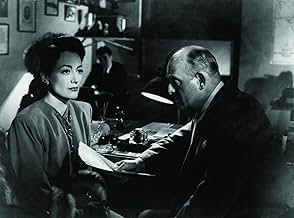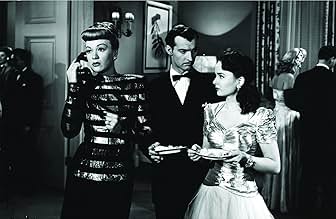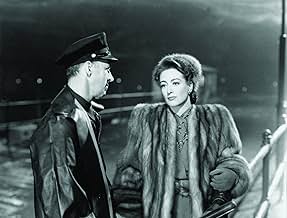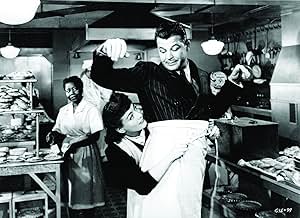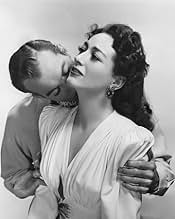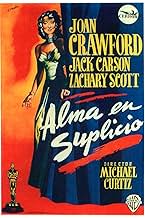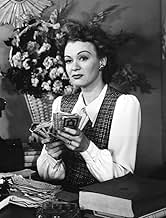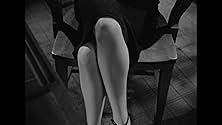IMDb RATING
7.9/10
30K
YOUR RATING
A hard-working mother inches towards disaster as she divorces her husband and starts a successful restaurant business to support her spoiled daughter.A hard-working mother inches towards disaster as she divorces her husband and starts a successful restaurant business to support her spoiled daughter.A hard-working mother inches towards disaster as she divorces her husband and starts a successful restaurant business to support her spoiled daughter.
- Won 1 Oscar
- 3 wins & 7 nominations total
Bill Alcorn
- Soldier
- (uncredited)
Betty Alexander
- Party Guest
- (uncredited)
Ramsay Ames
- Party Guest
- (uncredited)
George Anderson
- Peterson's Assistant
- (uncredited)
James Anderson
- Diner Customer
- (uncredited)
Robert Arthur
- High School Boy
- (uncredited)
Lynn Baggett
- Waitress
- (uncredited)
Leah Baird
- Police Matron
- (uncredited)
Summary
Reviewers say 'Mildred Pierce' is acclaimed for its strong female lead, complex dynamics, and themes of maternal love and social class. Joan Crawford's Oscar-winning performance is celebrated, and the film's noir elements are noted. However, some find the pacing slow and melodrama excessive, with Veda's character criticized. Despite this, it's seen as a classic with significant historical portrayal of women's roles.
Featured reviews
Joan Crawford won the Academy Award for Best Actress for her portrayal of the title character in this 1945 offering by Warner Brothers. Ms. Crawford was in her prime then and members of my generation, who remember her in films such as 1968's Berserk and 1970's Trog, are sometimes surprised to learn how attractive and talented she was in her heyday. The mean-spirited commentary of her life which we have been subjected to since her death in 1977 notwithstanding, still there was a certain hard edge to her personality which shown through in her screen roles. That she was able to win filmdom's greatest prize by playing a willing victim and vulnerable woman is perhaps the greatest tribute to her abilities as an artist. At any rate, she was the star of this film noir classic, a story that holds up well after 57 years. Mildred Pierce was an ordinary housewife of the era. No skills, relied on her husband for sustenance and leadership and was crushed when he ditched her for another woman. Her daughters were her whole life, doting unhealthily on Veda, the older one, especially (a very young Ann Blyth, herself nominated for Best Supporting Actress for this film). But, Veda was a schemer, conniver and social climber from the word go and it was ultimately her actions which brought an interesting human interest story to a thunderous climax. The story fascinates as we see Crawford, through iron will and determination, become an independent, successful business woman even as she makes tragic error after tragic error in her personal life. Mildred Pierce really is a rare animal, as it truly is more of a human interest story than any other in the film noir genre. The cast is great: Jack Carson, outstanding as Mildred's lifelong friend and would-be suitor, Bruce Bennett as Mildred's nice but weak-willed husband, Zachary Scott as the caddish successor to Bruce Bennett for Mildred's affections, and Eve Arden (still another nomination for Best Supporting Actress) in one of her trademark roles as a no nonsense gal pal. In Mildred Pierce, we have murder, love, misguided love, love not reciprocated, jealousy, misunderstanding, and good intentions/bad results. Could it be this film is so intriguing because we see in our own lives one or more of these very human conditions?
Mildred Pierce is directed by Michael Curtiz and adapted from the James M. Cain novel by Ranald MacDougall, William Faulkner and Catherine Turney. It stars Joan Crawford, Ann Blyth, Jack Carson, Zachary Scott, Bruce Bennett and Eve Arden. Music is by Max Steiner and the cinematographer is Ernest Haller. It was nominated for 6 Academy Awards and won just the one for Crawford in the Best Actress category.
Plot finds Crawford as Mildred Pierce, a devoted Mother of two girls who struggles to not only make her marriage work, but to also keep her eldest daughter, Veda (Blyth), in the luxurious life she demands. Murder, treachery and heartache is about to dog the Pierce family.
This is of course the film that is often remembered for being the film that saved Joan Crawford's career. After being dumped by MGM, and tagged with being box office poison, Crawford, it seemed, was destined to be the latest visitor to the acting scrap heap. But Jerry Wald over at Warner Brothers had other ideas. The part of Mildred had been offered to some of the big hitting ladies on the Warner studio lot, Stanwyck, Davies and Sheridan are just three of the names known to have shied away from the role. The feeling was that playing a woman with a mid-teen daughter was a no go for the age proud ladies. But Crawford, just entering her forties, took the role on, and in spite of initial protestations from director Curtiz, gave a terrific performance that landed her the coveted golden statuette and prolonged her film career for another 25 years.
Blending the psychological aspects of the woman's picture with the physical edges of film noir, "Mildred Pierce" is something of a unique picture. Very popular on release (it was a box office smash), it was thought that Cain's source novel wouldn't transfer well to the screen. Credit then to the writers for managing to create such an intriguing and watchable piece. True, they have had to tone down aspects from the book, and even added incidents and changed characters, but the essence is right and the timing couldn't have been more perfect for such a story. As film noir was becoming a telling style of film making, the pic also coincided with the later stages of WWII - a time when the role of the Woman, either in the service or at home, was under scrutiny. One of the great things about the film, and the performance of Crawford, is that it cobbles together many character strands of the 40s woman - in life and in film noir. She's a Suzy homemaker type, asked to be mother and wife, yet driven to be a business woman because she feels she's lacking in the necessary family home department. Where the film gets its noir flecks from is that Mildred may also be a murderer, a femme fatale, a woman whose every decision spells trouble. It's as if the makers (not just here but many others at the time) are saying that a woman's place is in the home, doing homely family stuff. Intriguing for sure, not necessarily in good taste, but an added spice into the melodramatic cooking pot that already contains greed and obsession.
Told with a flashback structure, the film is smoothly directed by the versatile Curtiz. But both he and Crawford are aided considerably across the board, not least by a truly great "Bitch" performance from Blyth. Veda is at one detestable, spoilt and mean, the daughter from hell, a status-seeking brat whose love comes at enormous cost to those who dare to get close to her. Blyth revels in it and her play off with Crawford is one of the film's major strengths. The support cast of Scott, Carson, Arden and Bennett are excellent value, while Steiner's music is unobtrusive and able to shift freely with the narrative twists. Finally it's left to Hallers photography to capture the feel and mood of the unfolding story. Shifting from sunny suburbia one moment to shadowy expressionistic bleakness the next, the photographer of such notable film's like "Gone With the Wind" and "Rebel Without a Cause", is integral to the moody excellence of "Mildred Pierce".
A murder mystery flanked by asides of class distinction, bad parenting, dubious sexual leanings and pure greed. Yep, "Mildred Pierce" is no ordinary movie - and hooray for that. 8.5/10
Plot finds Crawford as Mildred Pierce, a devoted Mother of two girls who struggles to not only make her marriage work, but to also keep her eldest daughter, Veda (Blyth), in the luxurious life she demands. Murder, treachery and heartache is about to dog the Pierce family.
This is of course the film that is often remembered for being the film that saved Joan Crawford's career. After being dumped by MGM, and tagged with being box office poison, Crawford, it seemed, was destined to be the latest visitor to the acting scrap heap. But Jerry Wald over at Warner Brothers had other ideas. The part of Mildred had been offered to some of the big hitting ladies on the Warner studio lot, Stanwyck, Davies and Sheridan are just three of the names known to have shied away from the role. The feeling was that playing a woman with a mid-teen daughter was a no go for the age proud ladies. But Crawford, just entering her forties, took the role on, and in spite of initial protestations from director Curtiz, gave a terrific performance that landed her the coveted golden statuette and prolonged her film career for another 25 years.
Blending the psychological aspects of the woman's picture with the physical edges of film noir, "Mildred Pierce" is something of a unique picture. Very popular on release (it was a box office smash), it was thought that Cain's source novel wouldn't transfer well to the screen. Credit then to the writers for managing to create such an intriguing and watchable piece. True, they have had to tone down aspects from the book, and even added incidents and changed characters, but the essence is right and the timing couldn't have been more perfect for such a story. As film noir was becoming a telling style of film making, the pic also coincided with the later stages of WWII - a time when the role of the Woman, either in the service or at home, was under scrutiny. One of the great things about the film, and the performance of Crawford, is that it cobbles together many character strands of the 40s woman - in life and in film noir. She's a Suzy homemaker type, asked to be mother and wife, yet driven to be a business woman because she feels she's lacking in the necessary family home department. Where the film gets its noir flecks from is that Mildred may also be a murderer, a femme fatale, a woman whose every decision spells trouble. It's as if the makers (not just here but many others at the time) are saying that a woman's place is in the home, doing homely family stuff. Intriguing for sure, not necessarily in good taste, but an added spice into the melodramatic cooking pot that already contains greed and obsession.
Told with a flashback structure, the film is smoothly directed by the versatile Curtiz. But both he and Crawford are aided considerably across the board, not least by a truly great "Bitch" performance from Blyth. Veda is at one detestable, spoilt and mean, the daughter from hell, a status-seeking brat whose love comes at enormous cost to those who dare to get close to her. Blyth revels in it and her play off with Crawford is one of the film's major strengths. The support cast of Scott, Carson, Arden and Bennett are excellent value, while Steiner's music is unobtrusive and able to shift freely with the narrative twists. Finally it's left to Hallers photography to capture the feel and mood of the unfolding story. Shifting from sunny suburbia one moment to shadowy expressionistic bleakness the next, the photographer of such notable film's like "Gone With the Wind" and "Rebel Without a Cause", is integral to the moody excellence of "Mildred Pierce".
A murder mystery flanked by asides of class distinction, bad parenting, dubious sexual leanings and pure greed. Yep, "Mildred Pierce" is no ordinary movie - and hooray for that. 8.5/10
James M Cain's novel 'Mildred Pierce' was much tougher, dirtier, violent and cynical than the gorgeously mounted movie it became, but the film still manages to maintain enough of the flavor of the book to be interesting. The portrait of working class life in Southern California works well, as does the depiction of a marriage that breaks down because of disappointment and resentment rather than anything melodramatic. Within its first hour MILDRED PIERCE captures something anxious about American life and marriages and families that is more true than most of what movies had shown up to that time, and it would prove to be even more so in the postwar world to come. The movie actually becomes more false and synthetic as it moves into Mildred's rise in life, but by then the plot and characters have taken hold.
And so has the film's increasingly bleak look at what women can expect when they live and work alone in a man's world, beset by men who want to exploit them, sexually and otherwise. This too, though softened from the book, would have seemed refreshingly frank to many of viewers at that time.
What raises the film to the level of classic is the first class work from every professional in every department. Joan Crawford is not much more expressive here than she was in her later MGM pictures, but this character suits her limited talents so well that she seems better than in almost anything else she did. All her Warners pictures used her more effectively than MGM usually managed to do, perhaps because in them she is invariably exploited, abused, maligned, even tortured. The bad behavior her Warners characters inspire in others is so extreme that she doesn't need to be. These plots do what Adrian's sometimes garish clothes did for her at MGM: they give her a personality, make her seem more interesting than she really was, and they make her sympathetic despite her essential coldness. Crawford gets able support from Ann Blyth, Eve Arden (as comedy relief; she is almost appearing in another movie entirely), Zachary Scott and especially Jack Carson, dead-on as a sweaty hustler and low rent lothario, bringing nuance to what could have been a one-note portrayal. Bruce Bennett isn't really a good actor in the role of Mildred's first husband, but he's perfectly cast -- he looks like an Okie from one of Dorothea Lange's photographs who went west to 'make it' and never did.
And as has been frequently mentioned here, Ernest Haller's cinematography (especially in the brilliant prints now being shown on cable) is consistently evocative and beautiful. So many of his shots live in the memory: in the scene where a mink wearing, gun wielding Mildred comes upon Monte and Vida kissing, the image is an almost primal one of betrayal and glamor -- the way their profiles are in darkness, the way Ann Blyth arches back against the bar, the hard, dim glitter of lame and the billows of tulle from her gown. The way Vida tumbles forward into almost blinding lamplight while Monte's face hardens behind her -- these are the kinds of wonderful images the best old films regularly delivered. Also excellent is Anton Grot's art direction, opulent but still managing to help create the particular SoCal atmosphere of this picture. And as usual, Max Steiner's score is effective, but as an earlier poster noted, he recycled a couple of motifs from his Oscar-winning score to NOW, VOYAGER. And director Michael Curtiz must be praised for keeping everything in perfect balance. This is one of the most admired '40s pictures and well worth a look.
And so has the film's increasingly bleak look at what women can expect when they live and work alone in a man's world, beset by men who want to exploit them, sexually and otherwise. This too, though softened from the book, would have seemed refreshingly frank to many of viewers at that time.
What raises the film to the level of classic is the first class work from every professional in every department. Joan Crawford is not much more expressive here than she was in her later MGM pictures, but this character suits her limited talents so well that she seems better than in almost anything else she did. All her Warners pictures used her more effectively than MGM usually managed to do, perhaps because in them she is invariably exploited, abused, maligned, even tortured. The bad behavior her Warners characters inspire in others is so extreme that she doesn't need to be. These plots do what Adrian's sometimes garish clothes did for her at MGM: they give her a personality, make her seem more interesting than she really was, and they make her sympathetic despite her essential coldness. Crawford gets able support from Ann Blyth, Eve Arden (as comedy relief; she is almost appearing in another movie entirely), Zachary Scott and especially Jack Carson, dead-on as a sweaty hustler and low rent lothario, bringing nuance to what could have been a one-note portrayal. Bruce Bennett isn't really a good actor in the role of Mildred's first husband, but he's perfectly cast -- he looks like an Okie from one of Dorothea Lange's photographs who went west to 'make it' and never did.
And as has been frequently mentioned here, Ernest Haller's cinematography (especially in the brilliant prints now being shown on cable) is consistently evocative and beautiful. So many of his shots live in the memory: in the scene where a mink wearing, gun wielding Mildred comes upon Monte and Vida kissing, the image is an almost primal one of betrayal and glamor -- the way their profiles are in darkness, the way Ann Blyth arches back against the bar, the hard, dim glitter of lame and the billows of tulle from her gown. The way Vida tumbles forward into almost blinding lamplight while Monte's face hardens behind her -- these are the kinds of wonderful images the best old films regularly delivered. Also excellent is Anton Grot's art direction, opulent but still managing to help create the particular SoCal atmosphere of this picture. And as usual, Max Steiner's score is effective, but as an earlier poster noted, he recycled a couple of motifs from his Oscar-winning score to NOW, VOYAGER. And director Michael Curtiz must be praised for keeping everything in perfect balance. This is one of the most admired '40s pictures and well worth a look.
The characterization of film noire is applied to certain films that touch on the grittier, more cynical aspects of life. This genre is typified as having lead roles played by strong, solemn male characters, in this respect, Mildred Pierce is an exception. In all other ways Mildred Pierce follows the model for a great film noire. The main character encounters both success and crushing emotional hardships, which the viewer gets to see the effects of. The supporting characters do a wonderful job depicting deceit in action, and each individual character contributes moving specific parts of the film along. The film ends with somewhat of an untied knot, and the viewer could certainly learn to love Mildred as the epitome of a "tragic hero". The film starts with a mystery and works it's way backwards, and as you can assume the viewer imagines he/she knows what is going on, when clearly the writer has us at his whims. Great acting. Great tragedy. Great film noire.
With those broad shoulders, those wall-to-wall eyebrows, that steely look on her face, and wrapped in those expensive clothes, the inimitable Joan Crawford exudes glamour and resolve as famed Mildred Pierce, housewife turned businesswoman, in this Michael Curtiz-directed film, part mystery, part melodrama.
The film's story, told in flashbacks, begins with mystery, and it is helped along by terrific B&W lighting. Most of the rest of the story is sheer melodrama, with talky dialogue that erupts from confrontations between various characters. The most important confrontations occur between Mildred and her ungrateful, scheming daughter Veda, who requires tons of money to be happy. As the story moves along, Mildred buys and successfully operates a restaurant, but it's not enough to win approval from her odious daughter. Mildred's love for Veda is deep. But Mildred, we learn, is also a take-charge woman who won't take any guff from anyone, at least from caddy suitors or prospective in-laws.
It's a great story. And in addition to the topnotch cinematography, the film has great production design, costumes, and editing. We're also treated to some pleasantly nostalgic music from the 1940s. Crawford gets good support performances from Ann Blyth, Eve Arden, and Jack Carson. I also liked Butterfly McQueen, the little lady with the high-pitched voice who plays Mildred's maid.
I suspect this film would have been worthy of praise, even with someone else playing the title character; the film is that good. But no other actress would have had the stage presence of the impressive Joan Crawford. It's mostly because of her that "Mildred Pierce" will be remembered and loved, for generations to come. It's also partly because of "Mildred Pierce" that Joan Crawford will be admired as a Hollywood legend, for generations to come.
The film's story, told in flashbacks, begins with mystery, and it is helped along by terrific B&W lighting. Most of the rest of the story is sheer melodrama, with talky dialogue that erupts from confrontations between various characters. The most important confrontations occur between Mildred and her ungrateful, scheming daughter Veda, who requires tons of money to be happy. As the story moves along, Mildred buys and successfully operates a restaurant, but it's not enough to win approval from her odious daughter. Mildred's love for Veda is deep. But Mildred, we learn, is also a take-charge woman who won't take any guff from anyone, at least from caddy suitors or prospective in-laws.
It's a great story. And in addition to the topnotch cinematography, the film has great production design, costumes, and editing. We're also treated to some pleasantly nostalgic music from the 1940s. Crawford gets good support performances from Ann Blyth, Eve Arden, and Jack Carson. I also liked Butterfly McQueen, the little lady with the high-pitched voice who plays Mildred's maid.
I suspect this film would have been worthy of praise, even with someone else playing the title character; the film is that good. But no other actress would have had the stage presence of the impressive Joan Crawford. It's mostly because of her that "Mildred Pierce" will be remembered and loved, for generations to come. It's also partly because of "Mildred Pierce" that Joan Crawford will be admired as a Hollywood legend, for generations to come.
Did you know
- TriviaAfter seeing the film, James M. Cain sent Joan Crawford a signed first edition of the original novel. The inscription read: "To Joan Crawford, who brought Mildred Pierce to life just as I had always hoped she would be, and who has my lifelong gratitude."
- GoofsMildred's house on Corvallis Street in Glendale is shown as a one-story Spanish-style bungalow; however, the interior has a staircase leading to the bedrooms.
- Quotes
Ida Corwin: [to Wally about his lustful looks in her direction] Leave something on me. I might catch cold.
- Crazy creditsThe opening credits are presented with a background ocean scene that "washes" the credits on the screen.
- Alternate versionsAlso shown in computer colorized version.
- ConnectionsFeatured in Hollywood: The Fabulous Era (1962)
- SoundtracksYou Must Have Been a Beautiful Baby
(uncredited)
Music by Harry Warren
Lyrics by Johnny Mercer
Played and sung at Wally's club toward the beginning
Also played when Veda and Ted are at Wally's club
- How long is Mildred Pierce?Powered by Alexa
Details
- Release date
- Country of origin
- Languages
- Also known as
- El suplicio de una madre
- Filming locations
- Production company
- See more company credits at IMDbPro
Box office
- Budget
- $1,453,000 (estimated)
- Gross worldwide
- $11,751
- Runtime
- 1h 51m(111 min)
- Color
- Aspect ratio
- 1.37 : 1
Contribute to this page
Suggest an edit or add missing content




